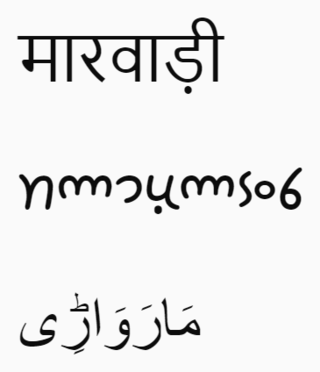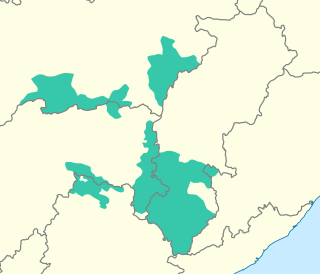Related Research Articles

Modern Standard Hindi, commonly referred to as Hindi, is the standardised variety of the Hindustani language written in Devanagari script. It is the official language of India alongside English and the lingua franca of North India. Hindi is considered a Sanskritised register of the Hindustani language, which itself is based primarily on the Khariboli dialect of Delhi and neighbouring areas. It is an official language in nine states and three union territories and an additional official language in three other states. Hindi is also one of the 22 scheduled languages of the Republic of India.

Urdu is a Persianised register of the Hindustani language, an Indo-Aryan language spoken chiefly in South Asia. It is the national language and lingua franca of Pakistan, where it is also an official language alongside English. In India, Urdu is an Eighth Schedule language, the status and cultural heritage of which are recognised by the Constitution of India; and it also has an official status in several Indian states. In Nepal, Urdu is a registered regional dialect and in South Africa, it is a protected language in the constitution. It is also spoken as a minority language in Afghanistan and Bangladesh, with no official status.
Bihari languages are a group of the Indo-Aryan languages. The Bihari languages are mainly spoken in the Indian states of Bihar, Jharkhand, Uttar Pradesh, and West Bengal, and also in Nepal. The most widely spoken languages of the Bihari group are Bhojpuri, Magahi and Maithili.

Marwari is a language within the Rajasthani language family of the Indo-Aryan languages. Marwari and its closely related varieties like Dhundhari, Shekhawati and Mewari form a part of the broader Marwari language family. It is spoken in the Indian state of Rajasthan, as well as the neighbouring states of Gujarat and Haryana, some adjacent areas in eastern parts of Pakistan, and some migrant communities in Nepal. There are two dozen varieties of Marwari.

The Gondi (Gōṇḍī) or Gond people, who refer to themselves as "Kōītōr", are an ethnolinguistic group in India. Their native language, Gondi, belongs to the Dravidian family. They are spread over the states of Madhya Pradesh, Maharashtra, Chhattisgarh, Uttar Pradesh, Telangana, Andhra Pradesh, Bihar, and Odisha. They are listed as a Scheduled Tribe for the purpose of India's system of reservation.

Mahakoshal or Mahakaushal is a region of central India. Mahakoshal lies in the upper or eastern reaches of the Narmada River valley in the Indian state of Madhya Pradesh. Jabalpur is the largest city in the region. Nimar region lies to the west, in the lower reaches of the Narmada valley.
Madiya or Maria is a Dravidian language spoken in India. It may be regarded as a dialect of Gondi, but is suspected to be mutually unintelligible with most other Gondi varieties.

Gondi (Gōṇḍī), natively known as Koitur, is a South-Central Dravidian language, spoken by about three million Gondi people, chiefly in the Indian states of Madhya Pradesh, Maharashtra, Chhattisgarh, Andhra Pradesh, Telangana and by small minorities in neighbouring states. Although it is the language of the Gond people, it is highly endangered, with only one fifth of Gonds speaking the language. Gondi has a rich folk literature, examples of which are wedding songs and narrations. Gondi people are ethnically related to the Telugus.

Kui is a South-Central Dravidian language spoken by the Kandhas, eastern Indian state of Odisha. It is mostly spoken in Odisha, and written in the Odia script. With 941,988 registered native speakers, it figures at rank 29 in the 1991 Indian census. The Kui language was also referred to as the Kuinga language during the historical period. It is closely related to the Gondi and Kuvi languages.
Koya is a South-Central Dravidian language of the Gondi–Kui group spoken in central and southern India. It is the native language of the Koya people. It is sometimes described as a dialect of Gondi, but it is mutually unintelligible with Gondi dialects.

Sambalpuri is an Indo-Aryan language variety spoken in western Odisha, India. It is alternatively known as Western Odia, and as Kosali, a recently popularised but controversial term, which draws on an association with the historical region of Dakshina Kosala, whose territories also included the present-day Sambalpur region.
Tula is one of the Savanna languages of Gombe State, northeastern Nigeria.
Hruso, also known as Aka (Angka), is a language of Arunachal Pradesh India. Long assumed to be a Sino-Tibetan language, it may actually be a language isolate. It is spoken by 3,000 people in 21 villages in Thrizino Circle, West Kameng District. The Hruso people inhabit areas of South East Kameng and are concentrated in the Bichom River Valley, and speak English, Hindi, and Miji in addition to Hruso.
Mono is a moribund Mbum language spoken by older adults in northern Cameroon.
Lere is an extinct Kainji dialect cluster of Nigeria. The ethnic population was cited as 16,000 in 2000, of whom only a few speak the language. A wordlist from the Takaya dialect can be found under External links.
Ziriya (Jiriya) and Sheni (Shaini) constitute a Kainji language of Nigeria. They are geographically but perhaps not linguistically distinct.
The Eighth Schedule to the Constitution of India lists the languages officially recognized by the Government of India. As of 2024, 22 languages have been classified under the schedule.

Pangwali is a Western Pahari language of Himachal Pradesh, India. It is spoken in the Pangi Tehsil of Chamba district, and is threatened to go extinct. Pangwali is natively written in the Takri script, but Devanagari is used as well. It is very similar to the Padderi language of Padder, J&K.
References
- ↑ Nagarchal at Ethnologue (25th ed., 2022)

- ↑ Nagarchal at Ethnologue (22nd ed., 2019)
